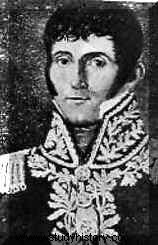February 16, 1769 (Auch) - May 21, 1809 (Lobau)
-

- Portrait of Spain
Jean-Louis-Brigitte Espagne, born in Auch on February 16, 1769 and died in Lobau on May 21, 1809, was a general of the Empire.
He enlisted at the age of 18 (July 6, 1787) in the regiment of the Queen's dragoons, then in garrison in Verdun. It was at this time that he became friends with the future general Alexandre Dumas (whose marriage he witnessed in Villers-Cotterêts in 1792) as well as with the dragoon Louis Chrétien Carrière Beaumont and the adjutant Joseph Piston. The story of these four dragoons of the Queen - who all became generals - and whose names of three of them are inscribed on the Arc de Triomphe in Paris prefigures in a certain way The Three Musketeers, the famous novel of the son of General Dumas.
He was appointed captain on September 2, 1792, to the hussars known as the Defenders of Liberty and Equality, from the 6th regiment. Lieutenant-colonel on November 30 and adjutant-general on September 23, 1793, he acquired these different ranks in the armies of Champagne and the North, under Generals Luckner, Rochambeau, Dumouriez, and that of the Pyrénées-Orientales under Labourdonnaie.
It was in the army of Sambre-et-Meuse that, appointed on 26 Frimaire Year V, brigade leader, he took command of the 8th cavalry regiment (cuirassiers). He made with this regiment, in the army of Mainz, under Haty, the campaign of the year VI and that of Germany under Augereau, and part of that of the year VIII in the army of the Danube, which commanded Jourdan.
The Directory having appointed him on 22 Messidor, brigadier general, and having sent him to serve under the orders of General Muller, in the army of observation, his presence in this army was short-lived.
On 7 Thermidor of the same year, he joined the Army of the Rhine, where, first under Lacombe and then under Moreau, he distinguished himself, on 10 Floréal, Year VIII, at the Battle of Moeskirch; on 30 Prairial, at that of Hochstedt, and on 8 Messidor at the battle of Neubourg. Charged with this last affair to attack the enemy on the heights of Unterhausen, he advanced on this plateau with the 1st and 3rd battalions of the 84th demi-brigade; after some efforts, the redoubt was taken, but d'Espagne, wounded in the arm, had to leave the field of battle. The following year, he fought, on 12 Frimaire, at Hohenlinden.
Laid off on 1st Vendémiaire, Year X, he had, on 6 Brumaire following, a command in the 21st military division, and he was still invested with it when he was appointed, on 17 Frimaire and 25 Prairial, Year XII, member and Commander of the Legion of Honor.
Promoted to the rank of general of division on 12 Pluviôse year XIII, he went to the army of Italy to take command of the light cavalry under Marshal Masséna, with whom he fought notably at Caldiero. On 12 Brumaire Year XIV, while pursuing the enemy on the way to Lonujo, he took 600 prisoners and managed to reach Leybach in the last days of the month.
Passed in 1806 to the army of Naples, his mission was to return to duty the Calabrian insurgents, commanded by Fra Diavolo, the most determined and fierce of galley slaves than Sidney Smith, repulsed from the island of Procida, had landed in Neapolitan territory, to avenge his defeat by murder, pillage and burning.
Some time later, recalled to the Grand Army, from Spain received there, on November 22, 1806, the command of the 3rd division of cuirassiers, with which he took, on June 10, 1807, a glorious part, and was seriously wounded in the Battle of Heilsberg, the Emperor took this opportunity to reward his services by making him, on July 11, Grand Officer of the Legion of Honor, then, in 1808, Count of the Empire.
It was while operating one of the charges which decided the success of the Battle of Essling, on May 22, 1809, that Spain was struck by a ball; taken to Lobau Island, he died there on the evening of that great day, as a result of his wound. His equestrian statue, which the Emperor, by decree of January 1, 1810, intended to decorate the Pont de la Concorde, was transported in 1816 to the Hôtel des Invalides. His name is inscribed on the east side of the Arc de Triomphe.
-

- Spain
